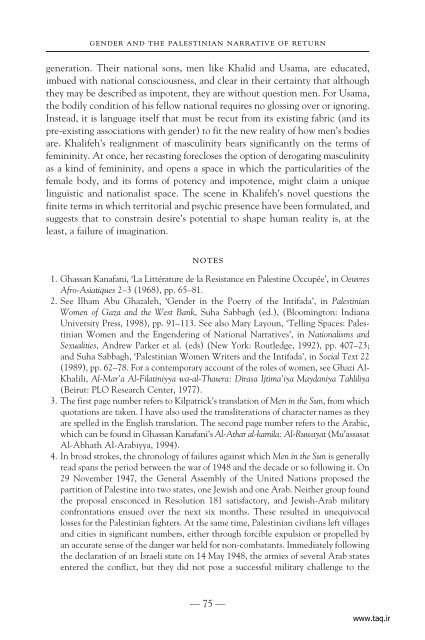LITERATURE AND NATION IN THE MIDDLE EAST
LITERATURE AND NATION IN THE MIDDLE EAST
LITERATURE AND NATION IN THE MIDDLE EAST
- No tags were found...
Create successful ePaper yourself
Turn your PDF publications into a flip-book with our unique Google optimized e-Paper software.
gender and the palestinian narrative of returngeneration. Their national sons, men like Khalid and Usama, are educated,imbued with national consciousness, and clear in their certainty that althoughthey may be described as impotent, they are without question men. For Usama,the bodily condition of his fellow national requires no glossing over or ignoring.Instead, it is language itself that must be recut from its existing fabric (and itspre-existing associations with gender) to fit the new reality of how men’s bodiesare. Khalifeh’s realignment of masculinity bears significantly on the terms offemininity. At once, her recasting forecloses the option of derogating masculinityas a kind of femininity, and opens a space in which the particularities of thefemale body, and its forms of potency and impotence, might claim a uniquelinguistic and nationalist space. The scene in Khalifeh’s novel questions thefinite terms in which territorial and psychic presence have been formulated, andsuggests that to constrain desire’s potential to shape human reality is, at theleast, a failure of imagination.notes1. Ghassan Kanafani, ‘La Littérature de la Resistance en Palestine Occupée’, in OeuvresAfro-Asiatiques 2–3 (1968), pp. 65–81.2. See Ilham Abu Ghazaleh, ‘Gender in the Poetry of the Intifada’, in PalestinianWomen of Gaza and the West Bank, Suha Sabbagh (ed.), (Bloomington: IndianaUniversity Press, 1998), pp. 91–113. See also Mary Layoun, ‘Telling Spaces: PalestinianWomen and the Engendering of National Narratives’, in Nationalisms andSexualities, Andrew Parker et al. (eds) (New York: Routledge, 1992), pp. 407–23;and Suha Sabbagh, ‘Palestinian Women Writers and the Intifada’, in Social Text 22(1989), pp. 62–78. For a contemporary account of the roles of women, see Ghazi Al-Khalili, Al-Mar’a Al-Filatiniyya wa-al-Thawra: Dirasa Ijtima’iya Maydaniya Tahliliya(Beirut: PLO Research Center, 1977).3. The first page number refers to Kilpatrick’s translation of Men in the Sun, from whichquotations are taken. I have also used the transliterations of character names as theyare spelled in the English translation. The second page number refers to the Arabic,which can be found in Ghassan Kanafani’s Al-Athar al-kamila: Al-Ruwayat (Mu’assasatAl-Abhath Al-Arabiyya, 1994).4. In broad strokes, the chronology of failures against which Men in the Sun is generallyread spans the period between the war of 1948 and the decade or so following it. On29 November 1947, the General Assembly of the United Nations proposed thepartition of Palestine into two states, one Jewish and one Arab. Neither group foundthe proposal ensconced in Resolution 181 satisfactory, and Jewish-Arab militaryconfrontations ensued over the next six months. These resulted in unequivocallosses for the Palestinian fighters. At the same time, Palestinian civilians left villagesand cities in significant numbers, either through forcible expulsion or propelled byan accurate sense of the danger war held for non-combatants. Immediately followingthe declaration of an Israeli state on 14 May 1948, the armies of several Arab statesentered the conflict, but they did not pose a successful military challenge to the— 75 —www.taq.ir






